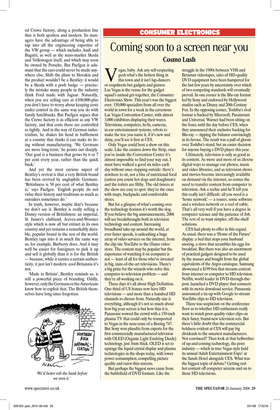Coming soon to a screen near you
Cosmo Lush
Vegas, baby. Ask any self-respecting geek what’s the hottest thing in this town and it isn’t lap-dancers or crapshoots but gadgets and gizmos. Las Vegas is the venue for the gadget squad’s annual get-together, the Consumer Electronics Show. This year’s was the biggest ever: 150,000 specialists from all over the world in town for a week in the cavernous Las Vegas Convention Center, with almost 3,000 exhibitors displaying their wares. Televisions, computers, hi-fis, cameras, in-car entertainment systems, robots to make the tea: you name it, if it’s new and shiny, you’ll see it first at CES.
Only Vegas could host a show on this scale. Like the casinos down the Strip, once you’re inside the Convention Center it’s almost impossible to find your way out. I must have walked a good six miles each day without once stepping outside: there’s nowhere to sit, not a bite of nutritional food (unless you count hot dogs and doughnuts) and the toilets are filthy. The old timers at the show are easy to spot: they’re the ones with maps, backpacks and comfortable shoes.
But for a glimpse of what’s coming over the technology horizon it’s worth the slog. If you believe the big announcements, 2008 will see breakthroughs both in television technology and content. Increasing broadband take-up around the world, at ever faster speeds, is unleashing a huge array of video services on the internet, from the clip site YouTube to the iTunes video store. The content may be popular but the experience of watching it on computer is not — least of all for those who’ve invested in big, state-of-the-art televisions. There’s a big prize for the wizards who solve this computer-to-television problem — and they’re all working on it.
These days it’s all about High Definition. One third of US homes now have HD televisions — and more than a hundred HD channels to choose from. Naturally size is everything, although it’s not so much about how big your screen is but how thin it is. Panasonic wowed the crowd with a 150-inch plasma TV that could only be transported to Vegas in the nose-cone of a Boeing 747. But Sony won plaudits from experts for the first commercially manufactured television with OLED (Organic Light Emitting Diode) technology, just 3mm thick. OLED is set to upstage the liquid crystal display and plasma technologies in the shops today, with lower power consumption, compelling picture quality and razor-thin screens.
But perhaps the biggest news came from the battlefield of DVD formats. Like the struggle in the 1980s between VHS and Betamax videotapes, sales of HD-quality DVD equipment have been hampered for the last few years by uncertainty over which of two competing standards will eventually prevail. In one corner is the Blu-ray format led by Sony and endorsed by Hollywood studios such as Disney and 20th Century Fox. In the opposing corner, Toshiba’s rival format is backed by Microsoft, Paramount and Universal. Warner had been sitting on the fence until the day before CES, when they announced their exclusive backing for Blu-ray — tipping the balance convincingly in its favour. The result was a pall of gloom over Toshiba’s stand, but an easier decision for anyone buying a DVD player this year.
Ultimately, television is only as good as its content. As more and more of us choose digital ways to manage our photos, music and video libraries, and as television shows and movies become increasingly available on demand via the internet, so comes the need to transfer content from computer to television. Ask a techie and he’ll tell you this really isn’t difficult: all you need is a ‘home network’ — a router, some software and a wireless network or a reel of cable. That’s all very well if you have a degree in computer science and the patience of Job. The rest of us want simpler, off-the-shelf solutions.
CES had plenty to offer in this regard. As usual, there was a ‘Home of the Future’ display: a bed that stops your husband snoring, a stove that scrambles his eggs for breakfast. But there was also an assortment of practical gadgets designed to be used by the masses and bought from the global equivalents of the Argos catalogue. Samsung showcased a $199 box that streams content from internet or computer to HD television. Netflix, world leader in DVD-through-thepost, launched a DVD player that connects with its movie download service. Panasonic announced a tie-up with Google to stream YouTube clips to HD television.
There was scepticism on the conference floor as to whether HD enthusiasts really want to watch poor-quality video clips on their fancy, brand-new television sets. But there’s little doubt that the commercial boldness evident at CES will pay big dividends to the smartest manufacturers. Not convinced? Then look at that bellwether of up-and-coming technology, the porn industry — which in true Vegas style held its annual ‘Adult Entertainment Expo’ at the Sands Hotel alongside CES. What was the biggest topic of debate? Getting redhot content off computer screens and on to those HD televisions.










































































 Previous page
Previous page